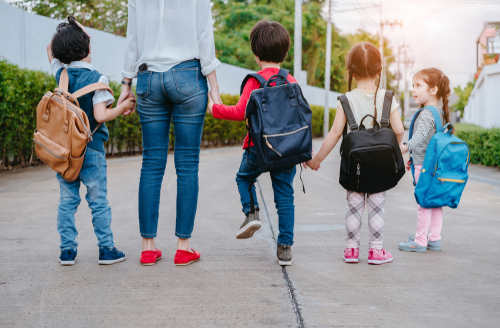
Getting ready to go to preschool can be really exciting—and a little bit scary. Changes in routine often benefit from pre-planning and practice.

Zero to Three and PBS Kids both have great articles on this topic. It’s likely that your child’s preschool teacher will use songs and chants to manage the classroom flow from one activity to another. Transition songs are wonderful “tools” in a teacher’s toolbox! Songs and chants convey information that can be repeated many times while retaining excitement and beauty. Singing a song about cleaning up is much more interesting than hearing (or saying!) “It’s time to clean up.”
Before Preschool Starts
Songs and chants can decrease the stress of the transition from home to school, too. If your little one is nervous about going to school, singing a few songs about school can encourage excitement about the new things they will experience. You might change the words to a well-known song to include verses about playing with new friends, learning new things, or having a snack or lunch. For instance, you might try singing these verses to the tune of “She’ll be Comin’ ‘Round the Mountain”:
I am going to my preschool today,
I am going to my preschool today,
I am going to my preschool, *I’m gonna play with friends,*
I am going to my preschool today!
You can change the words “I’m gonna play with friends” to any number of typical preschool experiences. Try replacing the phrase “play with friends” with “sit in circle,” “draw a picture,” “learn my letters,” or even simply “have a good time.”
Reassurances
Your preschooler may need extra reassurance that you (or someone they love and trust) will return at the end of the day. If you do not already have a song in your family repertoire that addresses this concern, consider the Music Together song “They Come Back.” This little tune combines a question-and-answer construction with a bit of humor to help young children articulate their feelings. If you are not a confident singer, consider singing along with the recording. Use exaggerated facial expressions and hugs to help communicate the idea that a reunion is only a few hours away. A free download of the song is available here.
After School
The period of time after school is another transition. If your child struggles to transition from school to home, consider using the same song, “She’ll Be Comin’ ‘Round the Mountain,” with new words to help your child reflect on the events of the day.
I went to my preschool today,
I went to my preschool today,
I went to my preschool and *we played outside,*
I went to my preschool today!
You can extend this sharing time by asking your child questions about their experience to get more detail: “What activity center did you choose first?” “Who did you play with when you played outside?” “Which activity was your favorite today?” “What was the most exciting thing that happened today?” Sing a new verse for each of their answers or just make up silly verses, and enjoy the time you spend with your child.
Songs Convey Emotion
The idea behind using songs in this way comes from what we know about music’s ability to communicate emotions. The melodic contour of a song (the way notes of the song move up and down to create the recognizable tune) and predictable rhythm (the divisions of the song’s pulse) provide developing brains with the necessary multi-sensory input to organize and process information, including information about emotion.
Some of the factors that influence how a person perceives the emotional component of a song include the following: familiarity with the particular song, familiarity with the singer’s voice or the rendition of the song, current emotional state, and culture. For a particularly good review of the neuroscience of children’s development, including how rhythm impacts this in positive ways, please review this talk by Dr. Laurel Trainor given at the Kennedy Center.
There is no single “right” song to help your child through transitions, so having a selection at your fingertips can be very helpful! “She’ll Be Comin’ ‘Round the Mountain,” may be familiar to some families, but others may be more familiar with “Hiné Ma Tov” or “Obwisana.” Choose a song that works for your family and make it your own. You will build a new tradition that will serve you through a variety of transitions.
And, don’t worry about making “mistakes”—as you sing, your child hears that you love them.
Author:
Carol Ann Blank, Ph.D., LCAT, LPC, MT-BC, Manager of Research and Special Needs Services, Music Together LLC



